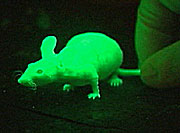Regrowing Nerves With Stem Cells
Researchers of AntiCancer, Inc. have accidentily made an important discovery.
Even for scientists, it's not every day you see a hairless mouse glowing bright green under a fluorescent light. And for scientists searching for stem cells that could grow into nerve or brain cells, seeing such a mouse meant finding a possible whole new source of such cells.
The scientists had given the mouse a gene so that areas would glow green where such stem cells might be found. They expected part of the mouse around the head to glow green. Instead, the entire mouse was aglow. "I'll never forget the minute that we made that observation," says Robert Hoffman, president of AntiCancer, Inc., where the finding took place.
Because of that moment, which Hoffman says was, in fact, a "lucky discovery," company scientists have been working on what could be a new source of adult stem cells.
Their most recent research, published in Proceedings of the National Academy of Sciences (PNAS), shows that they've been able to use stem cells taken from a mouse hair follicle to help regenerate damaged nerves in mice. In previous research, also published in PNAS, they showed the stem cells could become special brain cells called neurons.
...
In their first experiments, they tried to, according to Hoffman, "convert the hair follicle stem cells into brain cells in the laboratory." When that worked, he says, "Then we knew there was a real relationship between the hair follicle stem cells and the brain stem cells." They then put them in mice, and found they still formed neurons.
From there they worked with mice with injured nerves. "We injected these hair follicle stem cells into the area where the nerve or the spinal cord is severed… [and] found that the nerve or spinal cord could be regenerated because we injected these hair follicle stem cells," says Hoffman.

Potent stem cells in hair follicles glow green
Summarized: hair follicles of mice are an easily accessible source of stem cells with a very high potential (meaning they can turn into all sorts of tissues). If this is also true in humans, it would mean there is no more need for embryonic stem cells, thereby completely passing by the whole controversy that accompanies these embryonic stem cells.
There is an interesting, 1.5 minute movie clip available at the source.










No comments:
Post a Comment